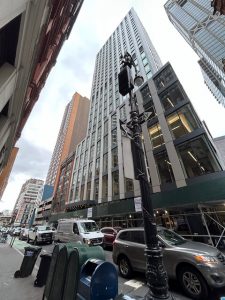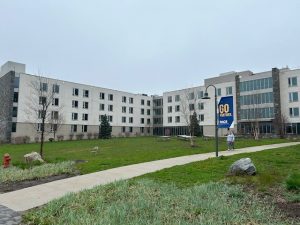Getting To Know: Pace University (NY)
My recent visits to Pace University reminded me that there are two types of college student in the Big Apple. The first are those who already live there; the second are those who want to. Pace University is the only private university in the country that lets students choose to live New York City every day or live nearby and come into the city when they want to.
This will be my first story where I report on a visit two campuses of the same university within a week.
I checked out Pace University in Manhattan first. The campus is located close to Wall Street and City Hall, and within walking distance of the Brooklyn Bridge. A week later, I visited the Westchester campus for a counselor’s event. That campus is just over an hour from Grand Central Station by Metro North train. Students at both campuses were excellent tour guides who gave me a fine understanding about why they chose Pace.
Pace University has over 5,500 undergrads in Lower Manhattan and just under 2,500 at the Pleasantville campus in Westchester County.
The university houses 40 percent of the undergrads in Lower Manhattan and 60 percent of those at Westchester. There is considerable academic overlap between both campuses. However, if you want to study nursing or writing, you must take your education at Westchester. The same is true if you’re an athlete. Interested in the visual or performing arts? Then you must go to Manhattan.
The school to watch at Pace University is the Seidenberg School of Computer Science and Information Systems.
Seidenberg offers seven undergraduate majors and two minors with extensive opportunities to explore artificial intelligence, cybersecurity, and machine learning. I dropped a photo of the cybersecurity lab in Westchester below.

No four-year public or private university within New York City has an undergraduate school dedicated exclusively to computer science disciplines. Nor do the SUNY campuses, New Paltz and Purchase that are closest to Pace. The nearest institutions that offer multiple options within a school that is dedicated to computer science are probably Stevens Institute of Technology (NJ) which is far more selective than Pace, and New Jersey Institute of Technology, which is less residential than Pace.
Going to college at Pace in Lower Manhattan has its pluses.
The Big Apple will always be a popular draw, especially for students interested in business, communications, health professions and the arts. However, it’s going to be quite expensive to live there, even though you will never need a car.It’s wise to learn how students find off-campus housing later in their education in the Big Apple. Pace took one residence hall, Maria’s Tower, offline last year, with plans to re-open it as a 480 bed hall for first-year students in 2026. After Maria’s Tower comes online, Pace should be able to house closer to half of their undergrads. As a frame of reference Fordham houses nearly half (47%) of its undergrads. NYU houses less than 40 percent, according to their recent Common Data Sets.
Pace’s Lower Manhattan location is among the best for any New York City college.
Not only is the housing within a short walk of any classes; the Fulton Center subway station is close by as well. It’s easy to get practically anywhere in the city from there. I dropped two photos below and one of One Pace Plaza up top. The campus is located along the Canyon of Heroes, home to world-famous ticker tape parades. I dropped a photo marking the parade for Neil Armstrong, Edwin “Buzz” Aldrin and Michael Collins, the Apollo 11 astronauts who completed America’s first mission to the moon in 1969.



While the campus neighborhood is certainly active during the workday, it is not as a rowdy at night as Washington Square at NYU. However, it you want to go to clubs or shop, you will ride the subway or share rides to get around. But while Pace has done a very nice job trying to keep classrooms and lab spaces up to date, the dining hall and student lounge spaces did not lead me to feel that I would be attending an expensive private college.
Going to college at Pace University in Westchester has its pluses, too.
Located in Pleasantville, off the Saw Mill River Parkway, the campus is about a mile from a commuter rail station where students can take Metro North trains into Manhattan. The ride is a little less than an hour into Grand Central Station in Midtown. It’s possible to intern twice a week and deal with the commute. Beyond that it might not be practical to balance the ride with a class schedule. However, the train schedule will not discourage students from going into the big city for fun. Aside from the train station, which has a nice diner nearby, Pleasantville is home to the Jacob Burns Film Center, a nonprofit five-screen cinema and film education center.
Pace University has an attractive campus in Pleasantville.
There’s no common design theme to the architecture on this campus as you will see in the photos that I dropped below. However, like the Lower Manhattan campus, the university appears to have paid more attention to the classroom and lab spaces, especially in nursing and computer science, versus the student common spaces such as the dining hall. The Nursing simulation labs were impressive. There is also a nice selection of on-campus housing options.






What are some comps to Pace in Westchester?
Pace’s 200-acre campus is larger and more spread out than Monmouth University (NJ), a school with a similar mix of academic programs that has nearly 1,500 more undergrads. Monmouth has a higher-profile athletic program, competing in 23 NCAA D-1 sports versus 14 D-2 sports at Pace. The New Jersey school houses about the same percentage of its undergrads as Pace; off-campus options are also less expensive. Monmouth students are more likely to intern in Central New Jersey. It takes over 90 minutes to get to New York-Penn Station by train.
Pace’s campus is also slightly smaller than Marist College (NY) which matches up with Pace in virtually every program outside of nursing. Marist houses about the same percentage of its undergraduate student body as Pace. Like Monmouth, Marist also competes in D-1 sports. However, it will take over an hour and a half to get into Manhattan by train from Marist’s Poughkeepsie campus. It isn’t realistic to commute regularly to New York City from Poughkeepsie to intern, but Marist offers a New York City Semester.
Small classes are another reason to consider Pace.
Eighty-eight percent of all classes offered on both campuses have fewer than 30 students. The school encourages students to take advantage of combined BA/MA or BS/MS degree paths as well as a 3+3 accelerated path to a law degree. An undergraduate student who is happy at Pace might want to consider these programs, especially if they want to do research with faculty, or pursue a professionally-oriented graduate degree. While Pace is a research university, it does not have many doctoral programs. So, bachelor’s and master’s degree students might receive more attention and more more closely with faculty than they would at larger schools.
Over 60 percent of Pace faculty are part time.
That’s a common practice at many urban universities that draw adjunct faculty from the business and professional communities. NYU, a much more expensive and far more selective school, has a similar percentage (57 percent). The good news: students get to learn from people who are working in their desired companies or industries. There’s an opportunity to build a pre-professional relationship to start a network. The downside: adjuncts come and go. They change jobs and get promoted at work and might later have no time to teach. In addition, while they have experience in their field, they were not all trained to be teachers.
Pace is rightfully proud of its career services.
A diligent student might get as much, maybe more, assistance at finding internships, clinical placements, and student teaching assignments than they would have received at NYU. It’s quite possible to leave Pace with three or more real-world experiences outside of the classroom that build a very impressive resume.This came out clearly from students on my tours. I was especially impressed with the efforts of the education and nursing programs to help the students gain experience as early as the sophomore year.
It’s not overly hard to get into Pace University.
Eighty-three percent of all applicants for the Class of 2027 were accepted. Admissions are test optional and less than a fifth of all applicants submitted scores. The average high school GPA was a 3.6, though nursing will be more selective and the arts programs have more thorough talent-based admissions. Pace’s yield rate, the percentage of accepted students who deposit, was only 9 percent. Apparently, Pace is shopped against other schools and does not usually end up as a first choice.
The costs really need to work out.
Pace might turn out to be less expensive than out-of-state charges for many public colleges, especially Rutgers and Penn State, for those who earn the larger scholarships. But housing costs are high, over $22,000 this year for those who live in university-owned housing in Manhattan and nearly $19,000 for students at Westchester. Not to mention that these are expensive places for entertainment and shopping.
Pace University met, on average, 76 percent of need for the Class of 2027.
That gap in dollars can be more than tuition and fees at a home state school About a third of the Class of 2027 received merit scholarships that averaged just over $25,000. They covered just over half of tuition, but not tuition and fees combined. Need-based scholarships averaged over $36,000. One positive, everyone who qualified for need-based aid received some form of grant or scholarship assistance, according to the university’s 2023-24 Common Data Set. New York residents may apply state grants towards educational costs. However, these awards do not make major dents at a school where tuition and fees alone exceed $51,000 and are nearly $55,000 in the performing arts programs.
Graduates in the Class of 2023 who borrowed owed, on average, nearly $39,000.
That’s $12,000 over the maximum that a graduate could borrow over four years through the Federal Student Loan program. A fifth had to take out private loans.
Costs have an impact on freshman retention and graduation rates.
Pace lost 23 percent of the freshmen who arrived in 2022 and nearly 30 percent of those who entered the year before. The four-year graduation rate for students who entered in 2017 was 49 percent. Fifty-nine percent finished in five years. These numbers were 50 and 60 percent for the students who entered in 2016. The retention and graduation rates would be less of a concern at a public college where students commute and might drop to part time enrollment to work more hours outside of school. However, Pace is an expensive private university.
New York has inexpensive public options compared to other states.
Honestly, I felt that a very cost-conscious New Yorker should look at the CUNY and SUNY offerings that compare with Pace or attend community college for the first two years if debt will be a major concern. Pace, to its credit, partners with community colleges and tries to make a transfer process work as seamlessly as possible. However, Pace in Pleasantville is located 20 minutes from SUNY-Purchase, which also offers an impressive selection of programs in the performing arts, with a shorter train ride to Manhattan. This campus is also 40 minutes from Ramapo College of New Jersey, which has co-op, as well as considerable overlap in business, communications, nursing and theatre arts.
Conclusions
Pace University might be a nice option versus private schools such as Hofstra, Long Island University, Marist, Monmouth, Quinnipiac, Scared Heart, or Seton Hall that also market convenient access to New York City. It has a lot to offer vs. Hofstra or NYU in the performing arts. Pace could also be a nice option versus going to public schools such as Rutgers, UConn or UDel as a non-resident student. But the costs have to work out.
Report Card: Pace University (NY)
- Four-Year/Six-year Graduation Rate: C/C
- Freshman Retention: C
- Costs: D
- Community: A
- Curriculum: A
- Comforts: B+
- Connections: A (New York and NJ Metro Area)/ C (Elsewhere)
Buy my new book, The Good College!
Listen to my latest interview on ‘Tests and the Rest’ with Amy Seeley and Mike Bergin!
Check out my talk, What Exactly Is a Good College? hosted by test-prep experts Amy Seeley and Mike Bergin on Tests And The Rest!
Listen to my talk, College Is A Learning AND Living Community hosted by Dr. Cynthia Colon from Destination YOUniversity on Voice of America Radio!
Sharing is caring!

